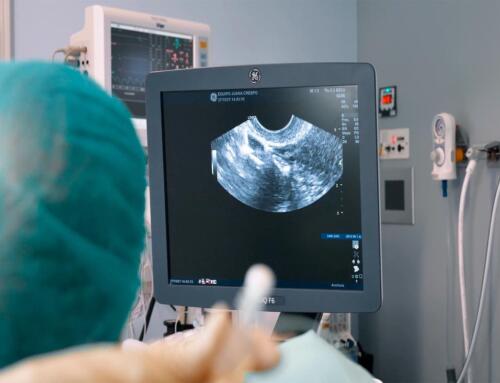Cervical ectropion (or glandular eversion of the cervix) is a condition of the female reproductive system in which the cells lining the cervical canal extend to the external surface of the cervix and may reach the vagina.
It is considered relatively common in women of reproductive age, and is more prevalent in pregnant women, adolescents and patients with prolonged use of contraceptives or hormone replacement therapy.
Cervical ectropion is usually an asymptomatic condition, but a significant increase in vaginal discharge or spotting during or after penetration can alert us to its presence.
On the other hand, and although mild lesions of cervical ectropion do not prevent pregnancy, its treatment in certain cases is advisable to avoid possible infections that put the mother or the baby at risk.
What is cervical ectropion? Definition
We will begin by explaining what cervical ectropion is.
As you know, the cervix is the lower, narrow part of the uterus, and forms a canal from the base of the uterus to the vagina. In this area there is a high concentration of specialized cells (epithelial cells) that are responsible for forming the lining tissue, known as the “central columnar epithelium“.
One of the characteristics of the cells of the central columnar epithelium is that they help the tissues to expand or flex during delivery.
Occasionally, this lining slowly slips away from the cervix and slides into the vaginal cavity, forming a bulge. As a result, erosion occurs in the area, with inflammation of the cells and the appearance of redness and/or injury. This is what we call cervical ectropion.
How is cervical ectropion diagnosed? Causes and symptoms
The erosion caused by cervical ectropion can create a red, “raw” appearance near the top of the vaginal opening. For diagnosis, therefore, it is necessary to perform a pelvic examination which, depending on the case, will include a Pap smear (cervical cytology) and colposcopy. These tests will make it possible to observe the cervix and the wound, and to evaluate the size and physical and cellular characteristics of the latter.
Since the origin of this condition is related to the action of estrogens, it is associated with hormonal alterations of puberty, menopause, pregnancy or oral contraceptive treatments.
Other causes of cervical ectropion are injuries after childbirth, allergies to intimate hygiene products or prophylaxis such as condoms or tampons, repeated candidiasis or untreated infections (HPV, chlamydia, candidiasis, herpes, gonorrhea, syphilis, etc.).
Symptoms:
Regarding its symptoms, they vary greatly in each woman and may be imperceptible.
Discomfort in the pelvic area, itching during urination or yellowish vaginal discharge with a strong odor are recurrent. In severe cases, pain and slight bleeding may be experienced during or after intercourse.
It is important that, in the presence of these symptoms, a doctor or gynecologist is consulted as soon as possible to perform an evaluation of the cervix, detect the origin of this injury and establish the most appropriate treatment.
What is the relationship between cervical ectropion and pregnancy?
Some women with cervical ectropion may have problems becoming pregnant. The reason is that this condition can alter the pH of the vagina, making it difficult for sperm to advance and reach the uterus.
In addition, if the wound is open or an infection occurs, bacteria can reach the fallopian tubes and cause pelvic inflammatory disease.
This occurs only in the most severe cases: when cervical ectropion is mild, it does not usually hinder pregnancy.
Another relevant issue is the prevalence of cervical ectropion in pregnancy due to the significant hormonal changes that occur during this period in the woman’s body.
In this case, the erosion or wound must be treated quickly, as a possible infection could reach the interior of the uterus and even the amniotic fluid, increasing the risk of miscarriage, premature delivery and infections with future complications in the baby’s development (growth retardation, alterations in eyes and/or ears, difficulty breathing).
Is cervical ectropion treatable
When the glandular epithelium is exposed, it has less cellular immunity, which presents a greater predisposition to replicate infections by external agents.
Women with cervical ectropion are more prone to develop herpes, human papillomavirus (HPV) or chlamydia, among other infections.
- You may be interested in: What happens if you have contracted human papilloma and are pregnant.
This, together with the multiple infecting agents, can favor the appearance of squamous intraepithelial lesions (SIL) and uterine cancer. Although this condition is not cancerous as such, when it is associated with the presence of HPV, the risk of cancerous cells is higher.
Treatment of cervical ectropion in pregnancy, before or after pregnancy, is essential to prevent worsening of symptoms, complications and the possible spread of infectious agents.
The measures will be different for each woman, depending on the type of injury and its cause.
- In mild cases, the condition may disappear with time and only periodic monitoring may be necessary.
- In other cases, the gynecologist may recommend using creams and ointments with antiseptic, hormonal or regenerative properties to help heal the injury.
- If the cause of the ectropion is directly linked to an STD infection, antibiotics, antivirals or antifungals, and some type of ointment will be necessary.
- Finally, when these treatments are insufficient or if after some time the woman continues to experience pain that affects her well-being and lifestyle, surgical treatment will be considered.
The first step is to eliminate hormonal therapy and discontinue the use of oral contraceptives.
Regarding interventions, cervical ectropion can be treated with cryotherapy (freezing the area) and diathermy (cauterizing). Both techniques are painless, can be performed on an outpatient basis and are permanent.
However, if the patient returns to taking oral contraceptives after a period of time, it is possible that the columnar epithelial tissues may regrow and spread.
Do you have any questions about your reproductive health or do you want to undergo our assisted reproductive techniques in Valencia? Feel free to contact us.
















